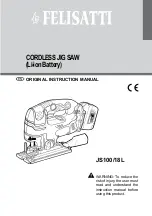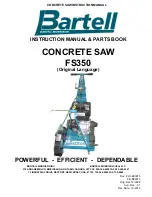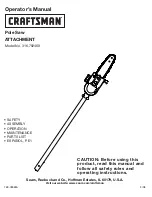
15
Insert cutting of larger work pieces, Fig. L
Work step:
Remove splitting wedge and upper machine cover. Attach
set cutting attachment to parallel stop. Adjust back kick
block with the work piece receiver and the check block.
Put work piece against the back kick block, evenly lodge
and feed up to the check block and retract in a safe posi-
tion.
After insert cutting: Promptly reinstall the wedge and
the upper cover.
Servicing
Pay attention to the safety instructions on page
GB8
.
D
Turn off the motor and pull the plug before servicing
or cleaning the machine.
All protection and safety devices must be immediately as-
sembled again following repairs and servicing.
1. The assemblage of the circular saw is largely service-
free, including the electric motor. Exceptions to this are
the normal wear and tear of the saw blades as well as
the bench insert. If needed, exchange the used bench
insert.
2. The bench surface should always be kept resin-free.
3. Keep the saw blade protection box free of wood and
chip residue. When the power plug is pulled, open the
protection box cover and remove any saw dust obstruc-
tions.
5. The motor brake is maintenance-free and will function
for at least 5000 switch operations. If the after-running
time exceeds ten seconds, please inform the manufac-
turer.
Belt change – Belt tension fig. 18 / 19
Attention! Pull the mains plug out.
1 Dismount protective cover (A).
Loosen the 9 cross-head screws, turn round the swing
gate at 45° using the hand wheel (B) and remove the
protective cover.
2 By loosening both hex nuts (C), you slack the drive
belt.
3 Now you can take off the drive belt from the front and
after that from the back belt pulley.
Mount the new driving belt in reverse order.
Pay attention, it should be laid out on the complete belt
pulley surface.
4 Then stretch the drive belt, tighten both hex nuts (C)
and remount the protective cover (A) on the housing.
Due to a low belt tension a loss of power is possible. Check
the belt tension and fix the problem by stretching the drive
belt.
Follow the procedure as mentioned in chapter 1, 2 and 4.
Electrical connection
The installed electric motor is completely wired ready for
operation.
The customer’s connection to the power supply system, and
any extension cables that may be used, must conform with
local regulations.
Motor braking unit
The
scheppach tku 4000 circular saw
bench
is fitted with
an automatic motor braking unit which becomes effective
as soon as the driving motor is switched off.
Important remark:
The electric motor is designed for the S 6 / 40 % operating
mode.
Therefore, the motor is automatically switched off in the
event of an overload. The motor can be switched on again
after a cooling down period that can vary.
D
Defective electrical
connection cables
Electrical connection cables often suffer insulation dam-
age.
Possible causes are:
1. Pinch points when connection cables are run through
window or door gaps.
2. Kinks resulting from incorrect attachment or laying of
the connection cable.
3. Cuts resulting from running over the connecting cable.
4. Insulation damage resulting from forcefully pulling out
of the wall socket.
5. Cracks through aging of insulation.
Such defective electrical connection cables must not be
used as the insulation damage makes them extremely haz-
ardous.
Check electrical connection cables regularly for damage.
Make sure the cable is disconnected from the mains when
checking.
Electrical connection cables must comply with the regula-
tions applicable in your country.
Single-phase motor
1. The mains voltage must coincide with the voltage speci-
fied on the motor’s rating plate.
2. Extension cables up to a length of 25-m must have a
cross-section of 1.5 mm
2
, and beyond 25 m at least
2.5 mm
2
.
3. The connection to the mains must be protected with a
16 A slow-acting fuse.
Three-phase motor
1. The mains voltage must coincide with the voltage speci-
fied on the motor’s rating plate.
2. The mains connection and the extension cable must
have 5 conductors: 3 phase cond 1 neutral con-
1 earth conductor.
3. The extension cable must have a minimum cable cross-
section of 1.5 mm
2
.
4. The connection to the mains must be protected with a
16 A slow-acting fuse.
5.
The rotating direction must be checked when the
machine is connected to the mains or re-sited. If
necessary, the polarity will have to be changed over
(wall socket).
Only a qualified electrician is permitted to connect the ma-
chine and complete repairs on its electrical equipment.
















































